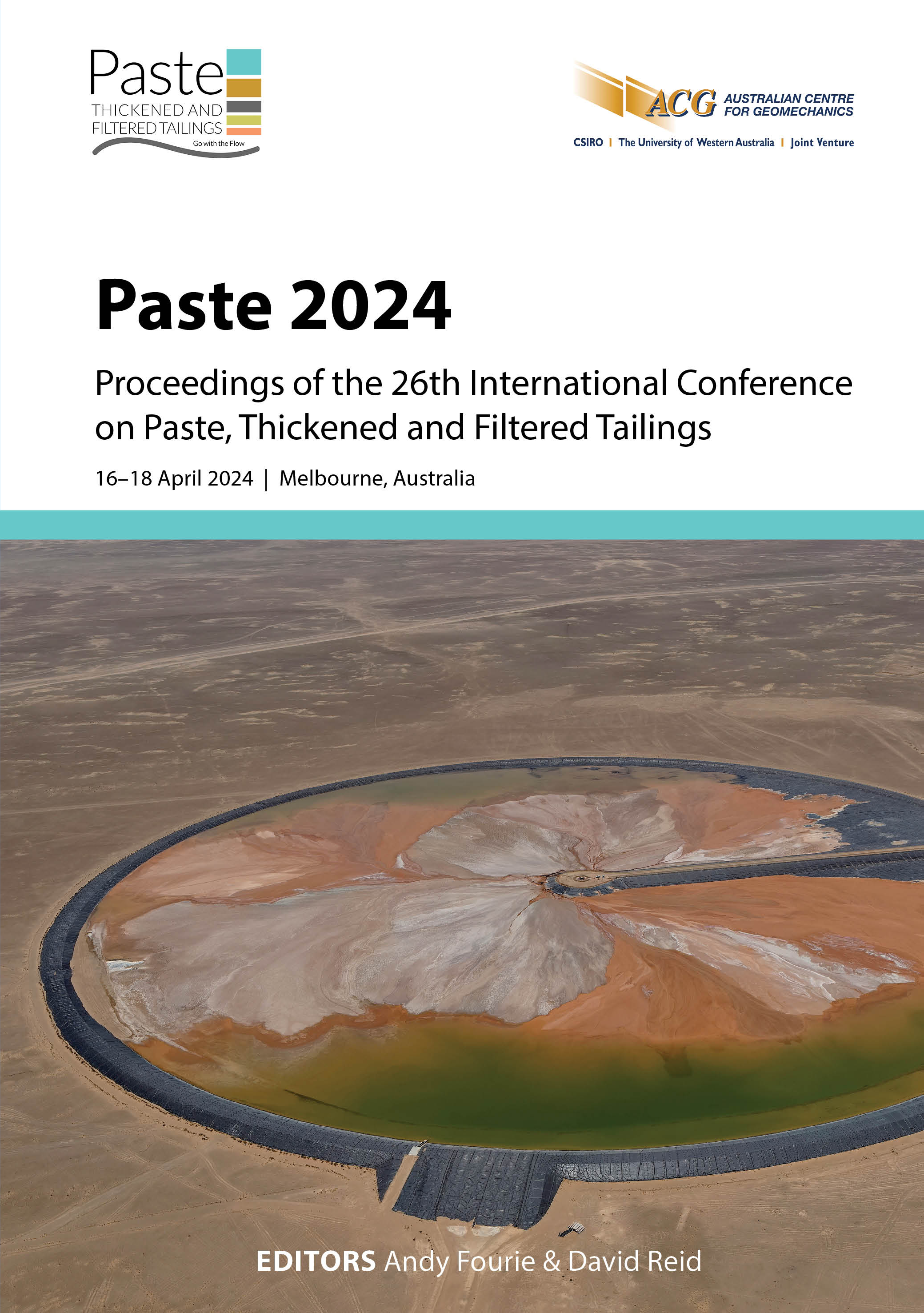Central thickened discharge scheme for Ma’aden’s Mansourah-Massarah Gold Project

|
Authors: Roshdieh, A; Soo, FC; Zare Al Ahmadi, K; Ibnu Hamdani, A; Putra Ginting, A; Gonzales Valdestamon, R; Javadi Rudd, S; Sedeghipour, M |
DOI https://doi.org/10.36487/ACG_repo/2455_18
Cite As:
Roshdieh, A, Soo, FC, Zare Al Ahmadi, K, Ibnu Hamdani, A, Putra Ginting, A, Gonzales Valdestamon, R, Javadi Rudd, S & Sedeghipour, M 2024, 'Central thickened discharge scheme for Ma’aden’s Mansourah-Massarah Gold Project', in AB Fourie & D Reid (eds), Paste 2024: Proceedings of the 26th International Conference on Paste, Thickened and Filtered Tailings, Australian Centre for Geomechanics, Perth, pp. 221-234, https://doi.org/10.36487/ACG_repo/2455_18
Abstract:
This paper provides a comprehensive case study detailing the inception, development, commissioning, and initial operations of a state-of-the-art tailings management facility in the Mansourah-Massarah Gold Project, situated within the arid terrain of the Kingdom of Saudi Arabia and operated by the Saudi Arabian mining company Ma’aden. With an annual average rainfall of a mere 80 mm and evaporation rates of 5,800 mm per annum, the mine relies on a water supply sourced from Taif town, a distance of 330 km. Commencing operations in 2022 and projecting a life span of 12 years, this operation is set to generate two types of tailings: oxide and sulphide (fresh) tailings, with a combined nominal production rate of approximately 4 million tonnes per annum. Given the arid setting and the substantial cost of water supply exceeding $4 per cubic metre, the rigorous management of water resources stands as a pivotal factor in tailings management selection. The primary objectives in tailings management for this project encompass the following key considerations: The recommended strategy for this project involves the installation of a paste thickener in conjunction with central thickened discharge storage of the paste-thickened tailings. The tailings management approach for this project will be implemented in three progressive stages. This paper explores the following facets of the project: For this project, a 40 m-diameter paste thickener has been employed, targeting an underflow solid concentration of approximately 65% for fresh tailings and 57% for oxide tailings. Initially, it was estimated that the maximum beach slope would be 1.3% during the commissioning phase, gradually improving to 2.3%. As of the time of preparing this article, the first beach survey has been conducted, suggesting that the actual achieved beach slope is approximately 2.1%, surpassing initial expectations.
Keywords: tailings management, central thickened discharge, gold tailings
References:
Peel, MC, Finlayson, BL & McMahon, TA 2007, ‘Updated world map of the Köppen-Geiger climate classification’, Hydrology and Earth System Sciences, vol. 11, issue 5, pp, 1633–1644.
Pirouz, B 2014, ‘Modified beach slope prediction model for non-segregating thickened tailings’, in RJ Jewell, AB Fourie, PS Wells
& D van Zyl (eds), Paste 2014 Proceedings of the 17th International Seminar on Paste and Thickened Tailings, InfoMine, Vancouver, pp. 31–46.
Pirouz, B, Javadi, S & Seddon, K 2020, ‘Comparison between linear and central distribution system for thickened tailings stacking’,
in H Quelopana (ed.), Paste 2020: 23rd International Conference on Paste, Thickened and Filtered Tailings, Gecamin Publications, Santiago,
Seddon, KD, Pirouz, B & Javadi, S 2018, ‘Stochastic modelling of beach profiles including the influence of thickener performance’,
in RJ Jewell & AB Fourie (eds), Paste 2018: Proceedings of the 21st International Seminar on Paste and Thickened Tailings, Australian Centre for Geomechanics, Perth, pp. 251–260,
Vietti, AJ, Boshoff, JCJ & Cope, A 2010, ‘Does thickening save water?’, in R Jewell & AB Fourie (eds), Paste 2010: Proceedings of the Thirteenth International Seminar on Paste and Thickened Tailings, Australian Centre for Geomechanics, Perth, pp. 33–39,
© Copyright 2025, Australian Centre for Geomechanics (ACG), The University of Western Australia. All rights reserved.
View copyright/legal information
Please direct any queries or error reports to repository-acg@uwa.edu.au
View copyright/legal information
Please direct any queries or error reports to repository-acg@uwa.edu.au
